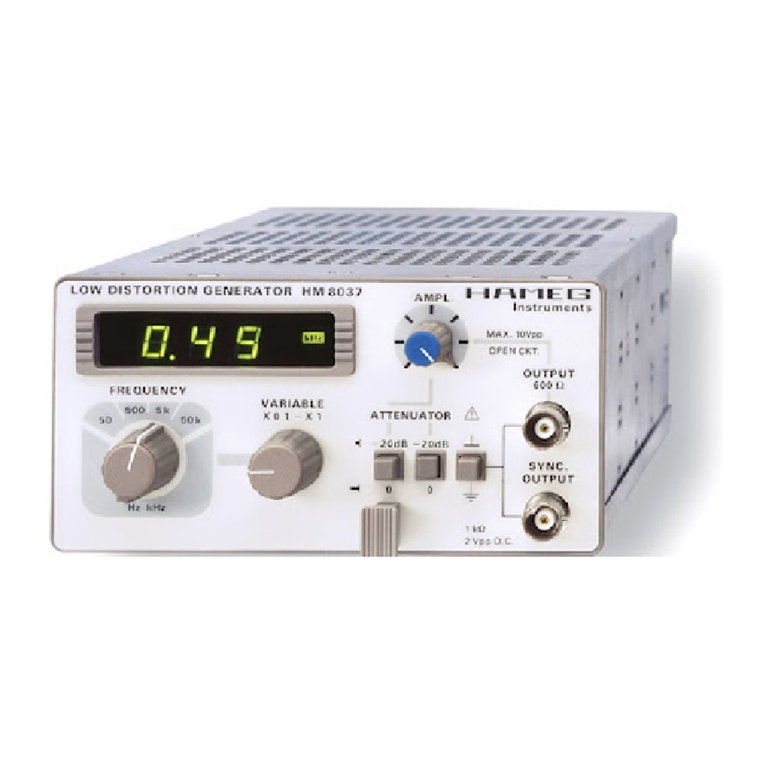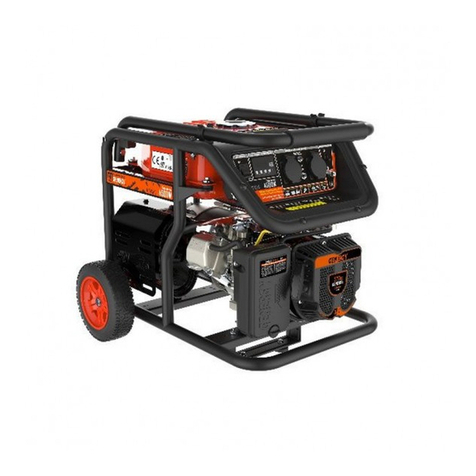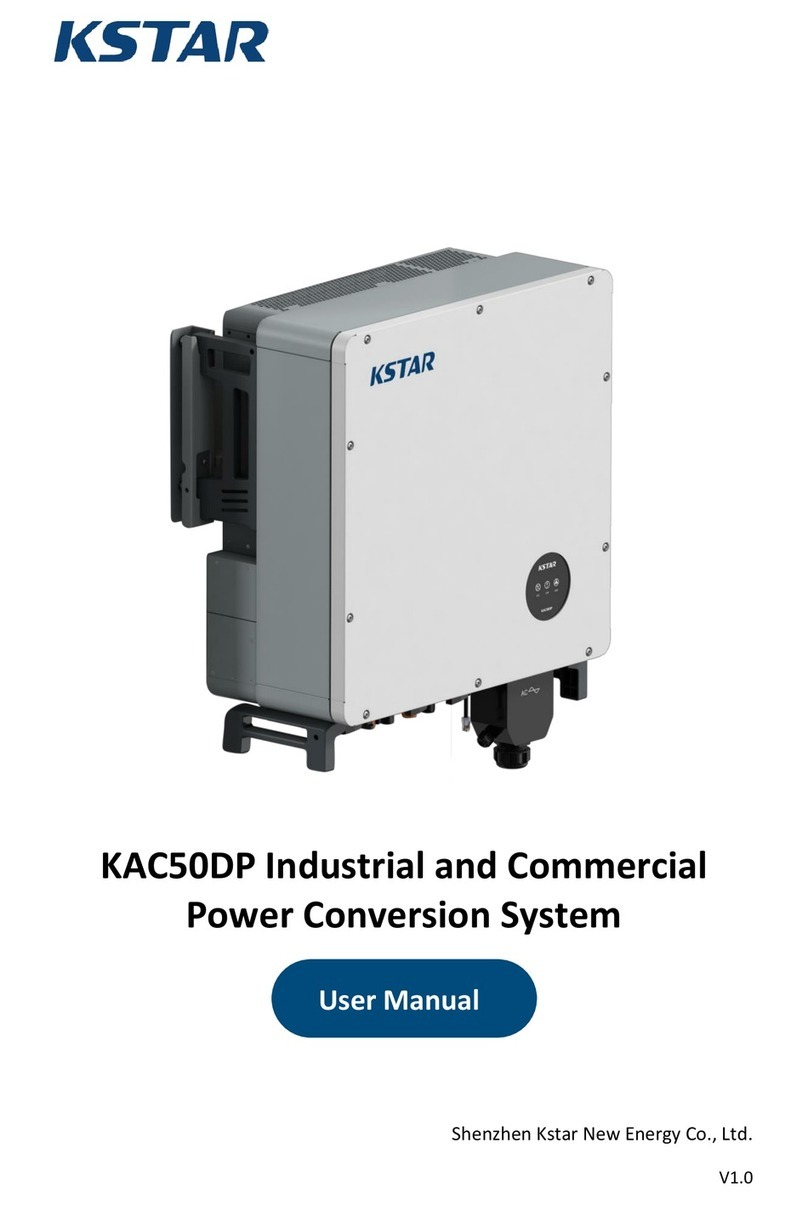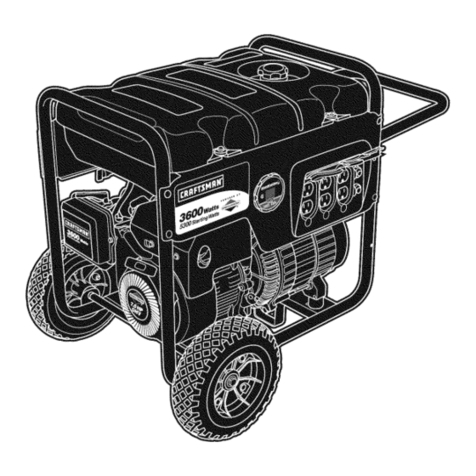GREENS X30 User manual

Generator Owner’s manual
[1]
PORTABLE GENERATOR
Owner’s Manual
X30 - X40 - X50 - X60 - X60E - X70T - X70MTE
SAVE THIS MANUAL FOR FUTURE REFERENCE
IMPORTANT SAFETY INSTRUCTIONS ARE INCLUDED IN THIS MANUAL

Generator Owner’s manual
[2]

Generator Owner’s manual
[3]
Content
INTRODUCTION ......................................................................................................................................................... 4
CHAPTER 1 –SAFETY RULES ...................................................................................................................................... 4
CHAPTER 2 –GENERAL INFORMATIÓN ..................................................................................................................... 7
2.1 Unpacking........................................................................................................................................................ 7
2.1.1 Packing contents....................................................................................................................................... 7
2.2 Assembly.......................................................................................................................................................... 7
2.2.1 Assembling the accessory kit.................................................................................................................... 7
CHAPTER 3 –FEATURES AND CONTROLS.................................................................................................................. 8
CHAPTER 4 –PRE-USE CHECKS .................................................................................................................................. 9
4.1 Engine oil filling................................................................................................................................................ 9
4.2 Fuel filling ........................................................................................................................................................ 9
4.3 Grounding the generator................................................................................................................................. 9
4.4 Battery connection (Electric start models only) .............................................................................................. 9
CHAPTER 5 —USE AND HANDLING......................................................................................................................... 10
5.1 Engine start-up .............................................................................................................................................. 10
5.2 Electrical connection of loads........................................................................................................................ 11
5.3 Engine shutdown........................................................................................................................................... 11
5.4 Low oil stop.................................................................................................................................................... 12
5.5 High-altitude operation ................................................................................................................................. 12
CHAPTER 6 –MAINTENANCE................................................................................................................................... 12
6.1 Maintenance table......................................................................................................................................... 12
6.2 General recommendations............................................................................................................................ 12
6.2.1 Generator maintenance ......................................................................................................................... 12
6.2.2 To clean the generator ........................................................................................................................... 13
6.2.3 Engine maintenance ............................................................................................................................... 13
6.2.4 Oil change............................................................................................................................................... 13
6.2.5 Replacement of the spark plug............................................................................................................... 13
6.2.6 Spark arrest............................................................................................................................................. 13
6.3 Air filter maintenance.................................................................................................................................... 13
6.4 Valve clearance.............................................................................................................................................. 14
6.5 General .......................................................................................................................................................... 14
6.6 Tips for storing the generator. ...................................................................................................................... 14
CHAPTER 7 –GENERATOR STORAGE....................................................................................................................... 14
CHAPTER 8 –TECHNICAL SPECIFICATIONS.............................................................................................................. 16

Generator Owner’s manual
[4]
INTRODUCTION
Thank you for purchasing powered by HONDA product.
We appreciate your business. Our generator is driven by
a compact air-cooled engine with high performance,
which can supply electrical power to operate power tools
on job sites, or to run home appliances during outage; or
provide power to remote locations where utility power is
unavailable.
This manual contains safety information to make you
aware of hazards and risks associated with generator
products and how to avoid them. It is important that you
read and understand these instructions thoroughly
before attempting to start or operate this equipment.
Save this original instruction for future reference.
If any portion of this manual is not understood, please
contact the nearest authorized dealer for starting,
operating, and servicing procedures. We also strongly
recommend you to instruct any other users who may
operate the generator in an emergency needed.
Every effort has been made to ensure that information in
this manual is both accurate and current. However we
reserves all rights to change, alter, or otherwise to
improve the generator and this documentation at any
time without prior notice.
CHAPTER 1 –SAFETY RULES
Read this manual carefully and become
familiar with your generator. Know its
applications, its limitations and any hazards
involved.
Throughout this brochure, on tags and decals affixed to
the generator, DANGER, WARNING, CAUTION and
NOTICE marks are used to alert personnel with special
instructions about a particular operation that may be
hazardous if performed incorrectly, or carelessly. Observe
them carefully. Their definitions are as follows:
Indicates a hazard which, if not avoided, could result in
death or serious injury.
Indicates a hazard which, if not avoided, could result in
death or serious injury.
Indicates a Hazard which, If not avoided, could result in
minor or moderate injury.
covers some practices which may be not related to
personal injury.
Safety Symbols and Meanings:
A running engine gives off carbon
monoxide, an odourless, colourless,
poison gas. Breathing carbon
monoxide could result in death,
serious injury, headache, fatigue, dizziness,
vomiting, confusion, seizures, nausea or
fainting.
• Operate this product ONLY outdoors.
• Install a battery operated carbon monoxide
alarm near the bedrooms.
• Keep exhaust gas away from entering a confined
area through windows, doors, ventilation intakes,
or other openings.
• NEVER operate this product inside any
building, carport, porch, mobile equipment,
marine applications, or enclosure, even if
windows and doors are open.
Starter cord kickback (rapid retraction) will pull hand and
arm toward engine faster than you can let go which could
cause broken bones, fractures, bruises, or sprains
resulting in serious injury.
• When starting engine, pull cord slowly until resistance
is felt and then pull rapidly to avoid kickback.
• NEVER start or stop engine with electrical devices
plugged in and turned on.

Generator Owner’s manual
[5]
Fuel and its vapours are extremely
flammable and explosive which could
cause burns, fire or explosion resulting
in death, serious injury and/or property damage.
WHEN ADDING OR DRAINING FUEL
• Turn generator engine OFF and let it cool at least 2
minutes before removing fuel cap. Loosen cap slowly to
relieve pressure in tank.
• Fill or drain fuel tank outdoors.
• DO NOT overfill tank, Allow space for fuel expansion.
• If fuel spills, wait until it evaporates before starting
engine.
• Keep fuel away from sparks, open flames, pilot
light, heat, and other ignition sources.
• Check fuel lines, tank, cap and fittings frequently for
cracks or leaks. Replace if necessary.
• DO NOT light a cigarette or smoke.
WHEN STARTING EQUIPMENT
• Ensure spark plug, muffler, fuel cap, and air cleaner
are in place.
• DO NOT crank engine with spark plug removed.
WHEN OPERATING EQUIPMENT
• DO NOT operate this product inside any
building, carport, porch, mobile equipment,
marine applications, or enclosure.
• DO NOT tip engine or equipment at angle
which cause fuel to spill.
• DO NOT stop engine by moving choke control
to “OFF” position.
WHEN TRANSPORTING, OR REPAIRING EQUIPMENT
• Transport/move/repair with fuel tank EMPTY or
with fuel valve OFF.
• DO NOT tip engine or equipment at angle which
cause fuel to spill.
• Disconnect spark plug wire.
WHEN STORING FUEL OR EQUIPMENT WITH FUEL IN
TANK
• Store away from furnaces, stoves, water heaters,
clothes dryers, or other appliances that have light
or another ignition source because they could ignite
fuel vapours.
Generator voltage could cause electrical
shock or burn resulting in death or serious
injury.
• Use approved transfer equipment to prevent back feed
by isolating generator from electric utility workers.
• When using generator for backup power, notify utility
company.
• Use a ground fault circuit interrupter in any damp or
highly conductive area, such as metal decking or steel
work.
• DO NOT touch bare wires or receptacles.
• DO NOT use generator with electrical cords which are
worn, frayed, bare or otherwise damaged.
• DO NOT operate generator in the rain or wet weather.
• DO NOT handle generator or electrical cords while
standing in water, while barefoot, or while hands or feet
are wet.
• DO NOT allow unqualified persons or children to
operate or service generator.
Exhaust heat/gases could ignite
combustibles, structures or
damage fuel tank causing a fire,
resulting in death, serious injury and/or property
damage. Contact with muffler area could cause burns
resulting in serious injury.
• DO NOT touch hot parts and AVOID hot exhaust gases.
• Allow equipment to cool before touching.
• Keep at least 5 feet (1.5m) of clearance on all sides of
generator including overhead.
Excessively high operating speeds could result in minor
injury and/or generator damage. Excessively low speeds
impose a heavy load.
• DO NOT tamper with governor spring, links or other
parts to increase engine speeds. Generator supplies
correct rated frequency and voltage when running at
governed speed.
Unintentional sparking could cause
fire or electric shock resulting in
death or serious injury.
WHEN ADJUSTING OR MAKING REPAIRS TO YOUR
GENERATOR
• Disconnect the spark plug wire from the spark plug and
place the wire where it cannot contact spark plug.

Generator Owner’s manual
[6]
WHEN TESTING FOR ENGINE SPARK
• Use approved spark plug tester.
• DO NOT check for spark with spark removed.
Starter and other rotating parts could entangle hands,
hair, clothing, or accessories resulting in serious injury.
• NEVER operate generator without protective housing or
covers.
•DO NOT wear loose clothing, jewelry or anything that
could be caught in the starter or other rotating parts.
• Tie up long hair and remove jewelry.
• DO NOT modify generator in any way.
Exceeding generators wattage/ amperage capacity could
damage generator and/or electrical devices connected to
it.
• DO NOT exceed the generator’s wattage/amperage
capacity. See Don’t Overload Generator in the Operation
section.
• Start generator and let engine stabilize before
connecting electrical loads.
• Turn electrical loads OFF and disconnect from generator
before stopping generator.
Improper treatment of generator could damage it and
shorten its life.
• Use generator only for intended uses.
• If you have questions about intended use, ask dealer or
contact local service center.
• Operate generator only on level surfaces.
• DO NOT expose generator to excessive moisture, dust,
dirt, or corrosive vapor.
• DO NOT insert any object through cooling slots.
• If connected devices overheat, to turn them off and
disconnect them from generator.
-or electrical output is lost.
-or equipment sparks, smokes, or emits flames.
-or unit vibrates excessively.
to turn them off and disconnect them from generator.

Generator Owner’s manual
[7]
CHAPTER 2 –GENERAL INFORMATIÓN
2.1 Unpacking
• Set the carton on a rigid flat surface.
• Remove everything from carton except generator.
• Open carton completely by cutting each corner from top
to bottom.
• Leave generator on carton to install wheel kit.
2.1.1 Packing contents
1-Owner’s Manual
2-Wheels
1-Handle Assembly
2-Wheel Axle
1-Hardware Bag (including 1-Spark Plug Socket; 1-
Extension Housing)
The above contents in this manual are for reference only
and do not represent for any specific model.
2.2 Assembly
The generator requires some assembly prior to using it.
2.2.1 Assembling the accessory kit
The wheels are designed to the unit to greatly
improve the portability of the generator.
The wheels are Not intended for over-the-road use.
1. Refer to Figures to install wheels as shown.
• Slide the axle through the frame brackets.
• Slide on the hub, wheel and flat washer, then insert the
cotter pin through the wheel axle hole.
• Bend the cotter pin tabs outward to lock the pin in
place.
2. The wheel bumpers as shown.
• Insert an M6 bolt through the rubber bumper and insert
an M8 bolt through the bottom of the bumper bracket.
Secure the bolt with an M8 flange nut.
• Install an M8 bolt through the generator frame and
through top of the bumper bracket. Secure the bolt with
an M8 flange nut.
3. Refer to following Figure to install the handle assembly
as shown.
• Insert the handle bracket onto the generator frame and
secure with two M8 bolts and two M8 flange nuts.
• Align the handle assembly holes with the handle
bracket holes and secure with one bolt and one M8 flange
nut.

Generator Owner’s manual
[8]
CHAPTER 3 –FEATURES AND CONTROLS
Read this Operator’s Manual and safety rules before operating your generator.
Compare the illustrations with your generator, to familiarize yourself with the locations of
various controls and adjustments. Save this manual for future reference.
We reserve the right to change the panel according to different countries. battery and digital hour meter are optional.

Generator Owner’s manual
[9]
CHAPTER 4 –PRE-USE CHECKS
4.1 Engine oil filling
Properly add the oil before using the generator Use
special additives. Select
the degree of viscosity of the oil according to the
expected operating temperature (see also
graph).
More than 40ºC, use SAE 30
Between 10ºC and 40ºC, use 10W-30
Less than 10ºC, use 5W-30 synthetic
Improper treatment of the generator
it could damage it and shorten its lifespan.
DO NOT attempt to start or start the engine before
checking the oil level. This could result in an engine break.
• Place the generator on a flat, level surface.
• Clean the area around the oil filler cap and remove the
oil cap/rod. Clean the level rod.
• Slowly fill the engine with oil until it reaches the full
mark on the rod. Stop filling from time to time to check
the oil level. Be careful not to overfill.
• Install the oil filling cap and tighten it correctly.
• Check the engine oil level before starting each time.
4.2 Fuel filling
Never fill the tank indoors. Never fill the
fuel tank with the engine running or
hot. Turn off the generator engine
and let the engine cool completely
before filling the fuel tank. Avoid spilling gasoline on the
HOT engine. Keep fuel away from sparks, flames, lights,
heat, and other ignition sources. DO NOT light a cigarette
or smoke when filling the fuel tank. The fuel is highly
FLAMMABLE, and its vapours are EXPLOSIVE.
• Use normal UNLEADED gasoline. Do not use fuel with
more than 10% ethanol and never use E85 fuel.
• Do not mix oil in gasoline.
• Install the fuel cap and clean up any gasoline spills.
Do not overfill the fuel tank.
Leave room for fuel expansion.
IF the fuel tank is too full,
it can spill over the HOT engine
and cause a FIRE or EXPLOSION. If fuel spills, wait until it
evaporates before starting the engine. Check the fuel,
tank, cap and accessories frequently for cracks or leaks.
Replace if necessary.
IMPORTANT: It is important to prevent the appearance of
rubbery deposits in the parts of the fuel system, such as
carburetor, fuel hose or tank during storage. Fuels mixed
with alcohol, ethanol (or methanol) can attract moisture,
leading to the separation and formation of acids during
storage. Acidic gas can damage the fuel system. Empty
the entire system if storage is to be performed for 30 days
or more. See the "Storage" section. Never use the engine
or use carburetor cleaners in the fuel tank as permanent
damage can occur.
4.3 Grounding the generator
The National Electrical Regulation requires that the
chassis and the external conductive parts of this
generator must be correctly connected to an approved
grounding.
A proper grounding will help to avoid electric shocks in
case of failure in the generator or electrical appliances. A
proper grounding also helps dissipate static electricity,
which often builds up in off-grounded devices.
4.4 Battery connection (Electric start models
only)
Before using the generator you must connect the
generator cables to the battery.
The battery is attached in its original location but is not
connected and the terminals are protected with covers.
•Lift the positive terminal cap
•Connect the RED cable to the positive terminal
•Attach the terminal cover again so that the cable
is protected
•Lift the negative terminal cap
•Connect the BLACK wire to the negative terminal

Generator Owner’s manual
[10]
•Attach the terminal cover again so that the cable
is protected
CHAPTER 5 —USE AND HANDLING
5.1 Engine start-up
Never start or stop the engine with
electrical devices plugged into receptacles and on
devices.
Unplug all electrical charges from the unit before starting
the engine.
Make sure the unit is in a level position.
SWITCH ON/OFF
Position the switch in the "ON" position
Position the fuel tap in the "ON" position
Position the starter cam in the OFF position
For starting, firmly grab the starter knob and pull slowly
until you feel increased resistance. At this point stretch
quickly and energetically upwards.
Starter knob
For electric starting, turn and hold the key on the start
switch to the "start" position until the generator starts. To
prolong the life of starter motor components: DO NOT
hold the key in the "START" position for more than 15
seconds and pause for at least 1 minute between start
attempts.
When starting the engine, move the starter lever to 1/2
until the engine runs smoothly and completely in the ON
position. If the motor destabilizes, position the stater

Generator Owner’s manual
[11]
again at position 1/2 until the engine runs smoothly and
then in the fully ON position again.
If the battery is not available, use the
starting instruction manual.
If the motor is not working properly,
position the grill lever in the OFF position and repeat the
starting procedure.
The recoil of the starter cable will push
your hand and arm into the engine faster than you can let
go, which could cause broken bones, fractures, bruises, or
sprains resulting in serious injuries.
When starting the motor, pull the wire slowly until you
notice resistance and then pull quickly to avoid recoil.
Never start or stop the engine with electrical devices
plugged in and turned on.
If the engine does not start after 3 pulls or if the unit shuts
down during operation, make sure the unit is on a level
surface and check the oil level. This unit can be equipped
with a low oil level protection device. If so, the oil level
must be checked for the engine to start and work.
Heat/exhaust gases can ignite fuel,
structures or cause damage to the fuel tank causing a fire
that can lead to death, serious injury and/or damage.
Contact with the muffler area could cause burns resulting
in serious injuries.
DO NOT touch hot parts and AVOID hot exhaust gases. Let
the equipment cool down before touching it.
Keep at least 152 cm of free space on all sides of the
generator, including the roof. Contact your equipment
manufacturer or dealer for a spark extinguisher designed
for the exhaust system installed in this engine. Spare parts
must be original and installed in the same position.
IMPORTANT
Do not overload the generator. Also, do not overload the
individual panel receptacles. These receptacles are
protected against overload with circuit breakers. If the
nominal amperage of any circuit breaker is exceeded, that
switch opens and the electrical output is interrupted.
5.2 Electrical connection of loads
• Let the engine run stably and warm up for a few
minutes.
• Plug and turn on electrical charges.
• Add the nominal powers of all the loads to be connected
at once. This total must not be greater than (a) the rated
power/amperage of the generator or (b) circuit breaker
of the receptacle supplying the power.
Turn on the generator and let the motor stabilize before
connecting the electrical loads. Connect the electrical
charges in the OFF position and then TURN THEM ON for
use. TURN OFF the electrical loads and disconnect them
from the generator before stopping the generator.
Exceeding the power/amperage of the generators could
damage the generator and/or the electrical devices
connected to it. DO NOT exceed
the power/amperage of the generator.
Overloading a generator in excess can result in damage to
the generator and connected electrical devices.
Note the following to avoid overloading the drive:
Add up the total power of all connected electrical devices
at once. This total should NOT exceed the power of the
generator. The rated power of the lights can be found in
the bulbs. The rated power of tools, appliances, and
motors can usually be found on a feature label or
adhesive. If the appliance, tool, or motor does not specify
power, multiply the volts by nominal amps to determine
the watts (volts × amps = watts).
Some electric motors, such as induction motors, require
about three times as many watts of power to start. This
demand lasts only a few seconds when the engines are
started. Make sure you have enough power for a start-up
when selecting electrical devices to connect to the
generator:
• Calculate the watts needed to start the larger motor.
• Add to that figure the operating watts of all other
connected loads.
The power reference guide is provided to help determine
how many elements the generator can use at a time.
5.3 Engine shutdown
Turn off all loads and then unplug them from the PLUGS
on the generator panel. Never start or stop the engine
with the electrical devices plugged in and turned on. Let
the engine run without load for several minutes to
stabilize the internal temperatures of the engine and
generator.
Move the ON/OFF switch to the OFF position.
Turn off the fuel tap.

Generator Owner’s manual
[12]
5.4 Low oil stop
The engine is equipped with an oil level sensor. This
sensor turns off the engine automatically when the oil
level is insufficient. If the engine shuts down on its own
and the fuel tank has enough gasoline, check the engine
oil level.
5.5 High-altitude operation
At altitudes above 1500 meters to continue to meet
emissions, an adjustment is required. Use without this
adjustment will result in decreased performance,
increased fuel consumption and increased emissions.
Consult an authorized dealer for high-altitude adjustment
information. Using the engine at altitudes below 760
meters with the high altitude kit is not recommended.
CHAPTER 6 –MAINTENANCE
6.1 Maintenance table
Follow the maintenance intervals shown below. A more
frequent service is required when the use is in adverse
conditions.
Models with GP engine (Model X30):
Models with GX engine:
** • Replace only type with paper element.
• Cyclonic type every 2 years or 600 hours.
(1) Perform the service more frequently when using it in zones
Dusty.
(2) The service of these parties shall be performed by their service
concessionaire,
unless you have the right tools and possess
sufficient mechanical knowledge. To view the procedures for
service, refer to the Honda workshop manual.
(3) For commercial applications, record hours of operation for
be able to determine the appropriate maintenance intervals.
(4) In Europe and in the other countries where the Machinery Directive
2006/42/EC applies, this cleaning should be carried out by your service dealer.
6.2 General recommendations
The generator warranty does not cover items that have
been subjected to abuse or neglect by the user. To enjoy
the warranty, the user must keep the generator as
indicated in this manual. Some adjustments/maintenance
will need to be made periodically to properly maintain the
generator. All maintenance specified in this manual must
be performed at the indicated periodicity (or lower in
case of exhaustive use). Follow the maintenance table.
Once a year replace the spark plug and air filter. A new
spark plug and clean air filter ensure a proper mix of air
and fuel and help the engine run better and last longer.
6.2.1 Generator maintenance
The maintenance of the generator consists of maintaining
the
clean and dry unit. Operate and store the unit in a
clean and dry environment where you are not exposed to
dust, dirt, moisture or corrosive vapors. Cooling fins
should not be clogged with snow or other elements. Be
sure to clean the generator frequently and clean when

Generator Owner’s manual
[13]
dust, dirt, oil, moisture or other foreign substances are
visible on the outside.
Never insert an object or tool between
the cooling fins, even if the engine is turned off.
DO NOT use a garden hose to clean the
generator. Water can enter the engine's fuel system and
cause problems. In addition, if water enters the generator
through the cooling air slots, some water will be retained
in rotor gaps and cracks and stator winding insulation.
Water and dirt accumulated in the generator's internal
windings can eventually decrease the insulation
resistance of the generators.
6.2.2 To clean the generator
• Use a damp cloth to clean exterior surfaces.
• A soft brush can be used to remove dirt, oil, etc.
• A vacuum cleaner can be used to collect dirt and debris.
• Low pressure air (not exceeding 25 psi) can be used to
blow dirt. Check the vents and openings in the generator.
These openings should be kept clean and unobstructed.
6.2.3 Engine maintenance
When handling the generator, always
disconnect the spark plug wire. Keep the cable away from
the spark plug and metal parts.
6.2.4 Oil change
Change the oil after the first twenty hours of
operation, then every 100 hours or 3 months thereafter.
If you use the generator under dirt, dust or in extreme
conditions change the oil more often.
Hot oil can cause burns. Let the engine
cool before draining the oil. Avoid skin contact with the
oil. If there is contact, clean yourself with soap and water.
Follow the instructions below to change the oil while the
engine cools:
• Clean the area around the oil drain plug.
• Remove the oil drain plug from the engine to drain the
oil into a suitable container.
• When the oil has drained completely, install the drain
plug and squeeze it tightly.
• Fill the engine with the recommended oil. (See "Before
starting the generator.")
• Clean the spilled oil.
• Dispose of used oil at a suitable collection center.
6.2.5 Replacement of the spark plug
Use the spark plug specified in the engine user manual.
Replace it once a year or every 300h, whichever comes
first. This will help the engine start more easily and work
better.
• Turn off the motor and disconnect the spark plug pipe.
• Clean the surface around the spark plug and remove the
spark plug.
• Make sure the distance between the electrode in the
new spark plug is 0.7-0.8mm.
When installing a new spark plug, squeeze it 1/2 turn after
the spark plug has settled to compress the washer.
When reinstalling a used spark plug, squeeze 1/8 to 1/4
back after the spark plug seats to compress the washer.
• Install the spark plug pipe
6.2.6 Spark arrest
• Turn off the generator and let the motor and muffler
cool completely before maintaining the spark
extinguisher (located on the back of the muffler).
• Remove the clamp and screen from the spark shutout.
• Clean the spark-extinguishing grid with a small wire
brush.
• Replace the spark extinguisher if it is damaged.
6.3 Air filter maintenance
• Open the air filter cover retainers, remove the air filter
cover, and remove the air filter element.

Generator Owner’s manual
[14]
• Wash the item in a solution of
cooking detergent and hot
water, and then rinse it
thoroughly, or wash it in non-
inflammable solvent
or high flash point. Or clean it
in high flash point solvent and
let it dry.
• Moisten the air filter element
in clean motor oil, and squeeze
the excess oil. If too much oil is
left in the element, the engine
will produce smoke during the
initial start.
Reinstall the air filter.
6.4 Valve clearance
Every 300 hours or every year (whichever comes first)
check the valve clearance in the engine and adjust if
necessary.
Important: If you have not performed this procedure
before or do not have the appropriate tools, take the
generator to an authorized distributor. This is a very
important procedure to ensure a longer engine life.
6.5 General
The generator must be started at least once every seven
days and run for at least 30 minutes. If this is not possible
or needs to be stored for more than 30 days, use the
following information as a guide for storage.
NEVER store the engine with fuel in the tank, in poorly
ventilated places or areas where fumes can reach an open
flame, spark or pilot light such as in an oven, water heater,
clothes dryer or other gas appliance.
Avoid self-ignition spraying through the spark plug hole.
Drain the fuel in an approved container, outdoors and
away from flames. Make sure the engine is cold. Do not
smoke when you perform this operation.
6.6 Tips for storing the generator.
Proper storage preparations are essential to keep the
engine trouble-free and looking good on the outside. The
following steps will help prevent oxidation and corrosion
from affecting the operation and exterior appearance of
the machine, and will make it easier to start the engine
when you use it again.
Cleaning
If the machine is running, wait for it to cool for at least
half an hour before cleaning. Clean all exterior surfaces,
touch up any damaged parts with paint, and coat other
parts that may rust with a thin layer of oil.
Do not use a garden hose or pressure washing equipment,
water can cause damage.
Fuel
Depending on the area where the equipment is intended
to be used, fuel formulas can deteriorate and rust quickly.
Fuel deterioration and oxidation can occur in as little as
30 days and can cause damage to the carburetor and/or
fuel system.
Gasoline oxidizes and deteriorates during storage.
Deteriorated gasoline makes it difficult to start, and
leaves accumulations of dirt that clog the fuel system. If
the engine's gasoline deteriorates during storage, you
may need to request service or replacement of the
carburetor and other fuel system components.
The period in which gasoline can remain in the fuel tank
and carburetor without causing functional problems will
depend on various factors, such as the mixture of
gasoline, the temperature of storage and the level of fuel
present in the tank. The air inside a partially filled fuel
tank deteriorates the fuel. Very warm storage
temperatures accelerate thefuel deterioration. Fuel
spoilage problems usually occur after a few months, or
even less if the gasoline was not new when the fuel tank
was filled.
The warranty does not cover damage to the fuel system
or operational problems due to improper storage
preparation.
You can extend the service life during fuel storage by
adding a gasoline stabilizer that is formulated for this
purpose, or you can avoid fuel spoilage problems by
draining the fuel tank and carburetor.
CHAPTER 7 –GENERATOR STORAGE
It is important to avoid the formation of rubber deposits
on essential parts of the fuel system such as the
carburetor, fuel hose or reservoir during storage. In
addition, experience indicates that fuels mixed with
alcohol (called gasohol, ethanol or methanol) can attract
moisture, which leads to the separation and storage
formation of acids. Acidic gas can damage an engine's fuel
system while it is stored.
To avoid engine problems, the fuel system must be
emptied before storage of 30 days or more, as follows:
• Remove all gasoline from the fuel tank.

Generator Owner’s manual
[15]
• Start and run the engine until it stops due to lack of fuel.
• While the engine is still hot, drain the oil from and fill
with the recommended grade.
• Remove the spark plug and pour approximately 15 ml
of engine oil into the cylinder. Cover the spark plug hole
with a cloth and pull the recoil starter a couple of times
to lubricate the piston and cylinder segments.
• Install and tighten the spark plug. Do not connect the
spark plug cable.
• Clean the outer surfaces of the generator. Verify that
the cooling fins and air intakes of the generator are not
clogged.
• Store the machine in a clean and dry place.

Generator Owner’s manual
[16]
CHAPTER 8 –TECHNICAL SPECIFICATIONS
Carbon dioxide (CO2)
emissions*
Check HONDA engine CO2 values in http://www.honda-
engines-eu.com/co2
*ThisCO2 measurement is the result of tests carried out in a fixed test cycle, under laboratory conditions, on a representative of the
reference engine of the engine type (engine family) and shall not imply or express any guarantee of the performance of a particular
engine.
Displacement 196cc 196cc 270cc
Max. Power(kW) 4.3kW 4.3kW 6.3kW
Rated Power(kW)3.3kW 3.3kW 4.6kW
Starting system Recoil Recoil Recoil
Fuel oil tank volume (L) 25L 25L 40L
Lube oil capacity (L) 0.6L 0.6L 1.1L
Rated Power (kW)2,8 2,8 4
Rated Voltage(V)230 230 230
Rated Current(A)12,1 12,1 17,4
Rated Frequency(Hz)50 50 50
Power Factor 1 1 1
Insulation Grade F F F
Dimension(mm)(L*W*H) 614x460x490 614x460x490 710x536x605
X30
X40
X50
GX270RT-VPX5
4,2
85
GP200H VXH3
3
49
GX200RT2-VPM4
3
49
Engine
Generator
Whole sets
Generator model
Model
Max. Power(kW)
Net Weight (kg)
Model
GX390RT2-
VPX9
GX390RT2-
VPE9
GX390RT2-
VPX9
GX390RT2-
VPE9
Displacement 389cc 389cc 389cc 389cc
Max. Power(kW) 8.7kW 8.7kW 8.7kW 8.7kW
Rated Power(kW)6.4kW 6.4kW 6.4kW 6.4kW
Starting system recoil E-Start recoil E-Start
Fuel oil tank volume (L) 40L 40L 40L 40L
Lube oil capacity (L) 1.1L 1.1L 1.1L 1.1L
Rated Power (kW)5,5 5,5 5,5 5,5
Rated Voltage(V)230 230 400 230/400
Rated Current(A)23,9 23,9 7,9 23,9/7,9
Rated Frequency(Hz)50 50 50 50
Power Factor 1 1 1 1
Insulation Grade F F F F
Dimension(mm)(L*W*H) 710x536x605 710x536x605 710x536x605 710x536x605
X70T
X60
6
6
6
X70MTE
X60E
92
92
6
92
92
Engine
Generator
Whole sets
Generator model
Max. Power(kW)
Net Weight (kg)

Generator Owner’s manual
[17]

Generator Owner’s manual
[18]

This manual suits for next models
6
Table of contents
Popular Portable Generator manuals by other brands
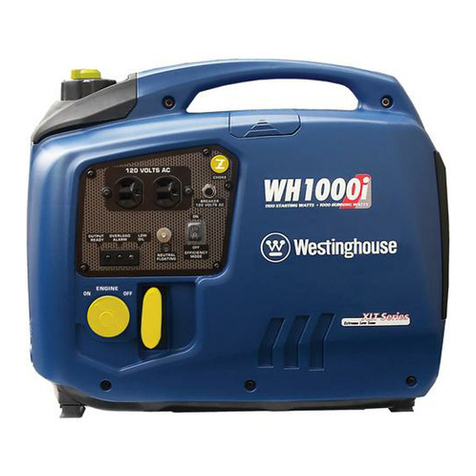
Westinghouse
Westinghouse WH2000i Series owner's manual
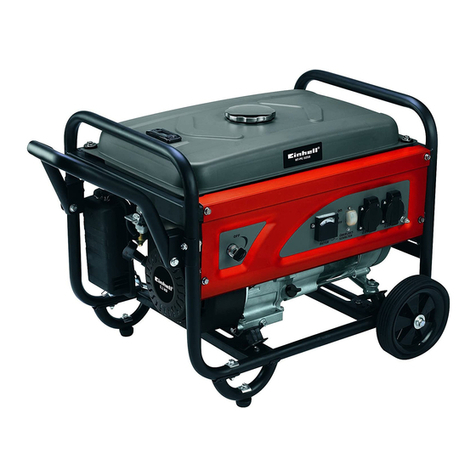
EINHELL
EINHELL RT-PG 3250 operating instructions
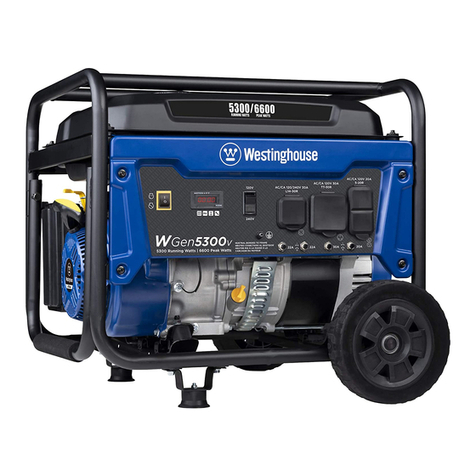
Westinghouse
Westinghouse WGen5300v user manual

Champion Global Power Equipment
Champion Global Power Equipment 201188 Operator's manual

Parat
Parat PARAPROJECT Case UC20 UltraCharge user manual
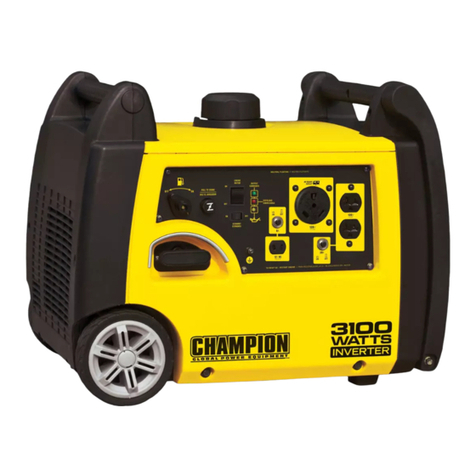
Champion
Champion 75531i Owner's manual & operating instructions
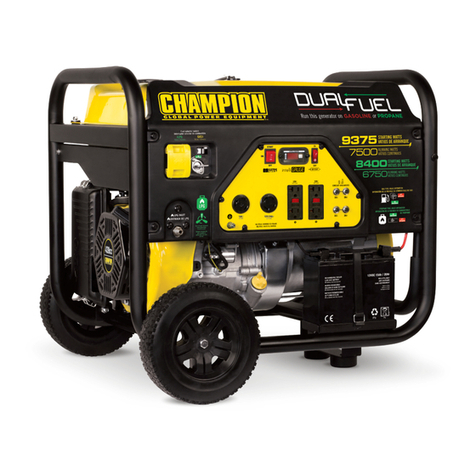
Champion
Champion 100165 Operator's manual

Coleman
Coleman Powermate PM0463300.01 installation instructions
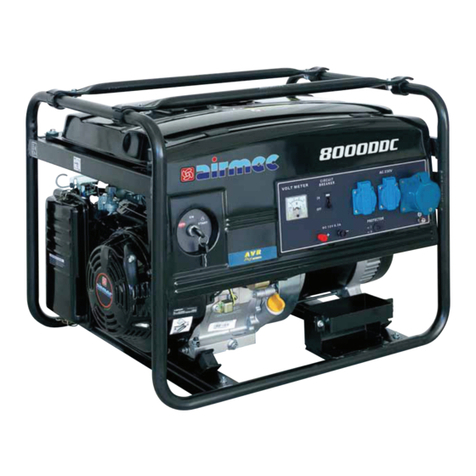
AIRMAC
AIRMAC LC 1800 DC instruction manual
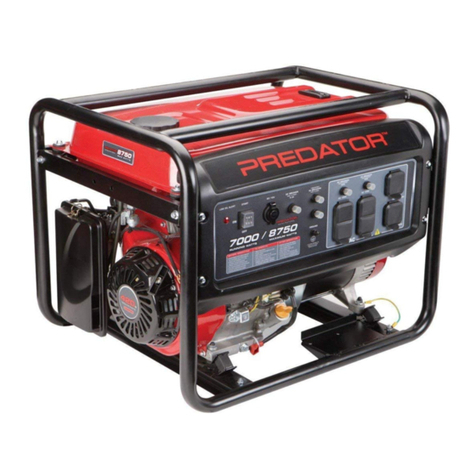
Predator
Predator 68525 owner's manual

Champion Global Power Equipment
Champion Global Power Equipment 200962 quick start guide
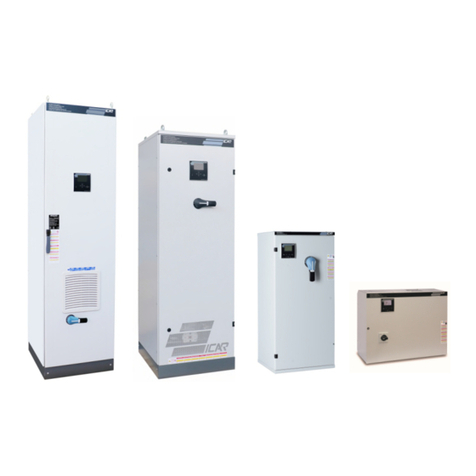
Icar
Icar MICROmatic Installation, operating and maintenance manual


